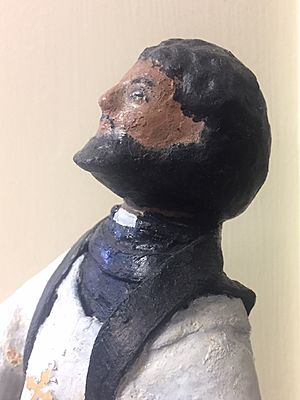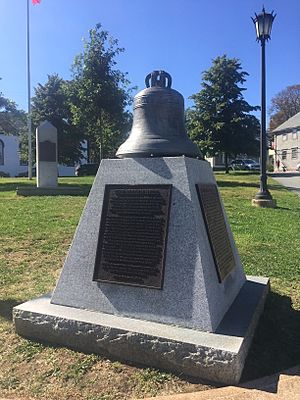Lunenburg campaign (1758) facts for kids
Quick facts for kids Lunenburg campaign |
|||||
|---|---|---|---|---|---|
| Part of the French and Indian War | |||||
 Jean-Baptiste Moreau, buried many of the 32 killed |
|||||
|
|||||
| Belligerents | |||||
| Mi'kmaq militia Acadian militia |
|||||
| Commanders and leaders | |||||
| Lieut-Colonel Patrick Sutherland Dettlieb Christopher Jessen Joseph Gorham Captain Rudolf Faesch (3rd Battalion, 60th Regiment of Foot) Montgomery's regiment Naval Captain Silvanus Cobb |
Charles Deschamps de Boishebert Chief Joseph Labrador Chief Paul Laurent |
||||
| Strength | |||||
| 30 | unknown | ||||
| Casualties and losses | |||||
| 32 killed | none | ||||
The Lunenburg campaign was a series of attacks by Mi'kmaq and Acadian militia groups. They targeted the new European settlers, known as "Foreign Protestants," whom the British had brought to the Lunenburg Peninsula during the French and Indian War. The British sent soldiers like Joseph Gorham and his Rangers, along with Captain Rudolf Faesch and regular troops, to protect Lunenburg. The attacks were very effective. By November 1758, local leaders in Lunenburg said they weren't getting enough help from the British soldiers and needed more protection.
Contents
Why did the Lunenburg campaign happen?
Early British settlements in Nova Scotia
Even though the British took control of Acadia in 1710, most people in Nova Scotia were still Catholic Acadians and Mi'kmaq. To stop new Protestant settlements, the Mi'kmaq attacked early British towns like Shelburne in 1715 and Canso in 1720.
Later, a conflict called Father Le Loutre's War began. This happened when Edward Cornwallis arrived to start Halifax on June 21, 1749. The Wabanaki Confederacy, which included the Mi'kmaq, had a long history of defending their lands. They often fought against British settlers along the border between New England and Acadia.
Building forts and defending towns
The British quickly started building more settlements. To protect these new Protestant towns from Mi'kmaq, Acadian, and French attacks, the British built forts. These forts were in places like Halifax (1749), Bedford (1749), Dartmouth (1750), Lunenburg (1753), and Lawrencetown (1754). There were many raids on these villages, such as the Raid on Dartmouth in 1751.
After an attack on Lunenburg in 1756, Governor Lawrence tried to protect the area. He built small forts called blockhouses near the LaHave River, Mush-a-Mush (now Blockhouse, Nova Scotia), and at the Northwest Range (now Northwest, Nova Scotia). Even with these blockhouses, Mi'kmaq and Acadians kept raiding the area. They carried out eight raids over the next three years. A total of 32 people from Lunenburg were killed in these raids, and more were taken prisoner. The British said most of these attacks came from the Mi'kmaq and Acadians living near Cape Sable.
Continued attacks and British struggles
After the 1756 raid, Mi'kmaq groups made eight more attacks on the Lunenburg Peninsula. In 1757, they raided Lunenburg again, killing six people from the Brissang family. That same year, settlers in Lunenburg had to spend a lot of time on "militia duty," meaning they had to help defend the area. During the winter, 300 soldiers were stationed in Lunenburg.
In April 1757, Acadian and Mi'kmaq fighters attacked a warehouse near Fort Edward (Nova Scotia). They killed thirteen British soldiers, took supplies, and burned the building. A few days later, they also raided Fort Cumberland. Because the Acadian and Mi'kmaq militias were so strong, a British officer named John Knox wrote that the British only "imagined" they controlled Nova Scotia in 1757. He said the situation was so dangerous that British troops and settlers in forts like Fort Edward, Fort Sackville, and Lunenburg were like "prisoners."
By the end of 1757, Governor Charles Lawrence wrote that "More inhabitants were killed and taken prisoner." This made many people scared and in great distress. For example, settlers in Lawrencetown had to leave their homes completely because of the constant raids. In Dartmouth, half of the 151 settlers who arrived in 1750 left within two years due to attacks. By 1763, only 78 settlers remained in Dartmouth.
The Lunenburg campaign in 1758
In March 1758, the Mi'kmaq raided the Lunenburg Peninsula again. They attacked the Northwest Range (now Blockhouse, Nova Scotia) and killed five people from the Ochs and Roder families. On May 15, 1758, Captain Faesch left Halifax for Lunenburg with soldiers. Acadian privateers also attacked ships near Lunenburg.
By the end of May 1758, most people on the Lunenburg Peninsula left their farms. They moved to the safety of the forts around the town of Lunenburg. This meant they missed the planting season for their crops. For those who stayed on their farms, the attacks became even more frequent.

During the summer of 1758, the Mi'kmaq carried out four more raids on the Lunenburg Peninsula. This was in response to the British Siege of Louisbourg (1758). On July 13, 1758, a member of the Labrador family killed two boys near the LaHave River. The next attack happened at Mahone Bay, Nova Scotia on August 24, 1758. Eight Mi'kmaq attacked the homes of the Lay and Brant families, killing three people. Two days later, two soldiers were killed in a raid on the blockhouse at LaHave. On August 27, Joseph Stye, Conrad Halty, and his wife were buried.
On September 8, D.C. Jessen led 60 local militia members and 40 soldiers from the 60th Regiment. They searched the peninsula for a week but did not find the Mi'kmaq. During this time, on September 11, Mi'kmaq fighters captured a child in a raid on the Northwest Range.
After the Siege of Louisbourg (1758), Gorham's Rangers were stationed in Lunenburg for the winter. Even with these Rangers and the 60th Regiment there, Governor Lawrence wrote in December that the Mi'kmaq "had just destroyed a whole family." He said this was done in such a "bloody and barbarous manner" that it scared many people. Three-quarters of the settlers left their farms and moved into the town for safety.
What happened next?
The raids continued into the next spring. On March 27, 1759, three members of the Oxner family were killed. The last raid happened on April 20, 1759. The Mi'kmaq killed four settlers in Lunenburg from the Trippeau and Crighton families. In a letter dated September 20, 1759, Governor Lawrence continued to report that the Mi'kmaq and Acadian raids were slowing down the growth of the community. Acadian privateers also kept attacking ships near Lunenburg.
Rev. Jean-Baptiste Moreau was the minister in Lunenburg. He buried many of the people who died. He reported that the Mi'kmaq killed 32 people during this campaign.
Chief Paul Laurent of the LaHave Tribe surrendered to the British at Fort Cumberland on February 29, 1760. He then came to Halifax and signed a peace treaty on March 10, 1760.

